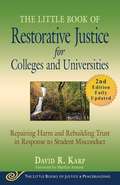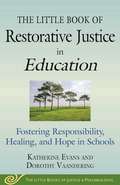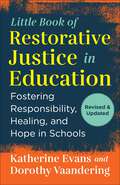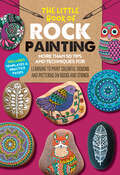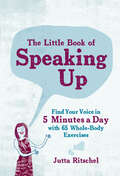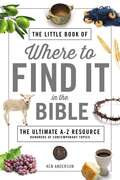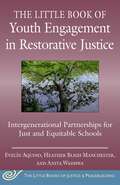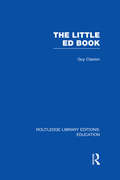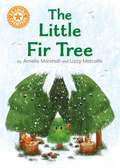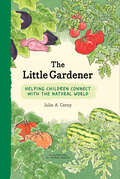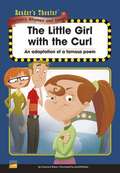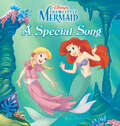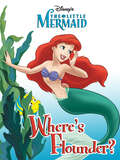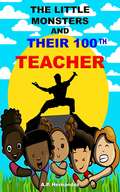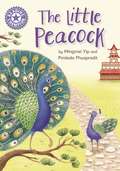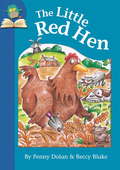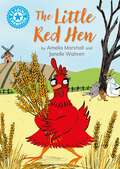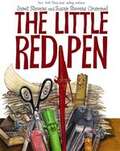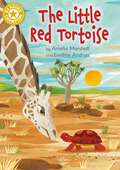- Table View
- List View
The Little Book of Restorative Justice for Colleges and Universities, Second Edition: Repairing Harm and Rebuilding Trust in Response to Student Misconduct (Justice and Peacebuilding)
by David R. KarpA Practitioner's Reference and Guide to Implement Restorative Justice on CampusHere’s a call to colleges and universities to consider implementing restorative practices on their campuses, ensuring fair treatment of students and staff while minimizing institutional liability, protecting the campus community, and boosting morale, from an associate dean of student affairs who has put these models to work on his campus.Restorative justice is a collaborative decision-making process that includes victims, offenders, and others who are seeking to hold offenders accountable by having them (a) accept and acknowledge responsibility for their offenses, (b) to the best of their ability, repair the harm they caused to victims and communities, and (c) work to reduce the risk of re-offense by building positive social ties to the community. David Karp writes in his introduction, “As a student affairs administrator, I have become deeply committed to the concept and practice of restorative justice. I have experienced how it can work given the very real pressures among campus conduct administrators to manage high case loads, ensure fair treatment, minimize institutional liability, protect the campus community, boost morale in a division with high turnover, and help students learn from their mistakes without creating insurmountable obstacles to their future successes.”
The Little Book of Restorative Justice in Education: Fostering Responsibility, Healing, and Hope in Schools (Justice and Peacebuilding)
by Dorothy Vaandering Katherine EvansMuch more than a response to harm, restorative justice nurtures relational, interconnected school cultures. The wisdom embedded within its principles and practices is being welcomed at a time when exclusionary discipline and zero tolerance policies are recognized as perpetuating student apathy, disproportionality, and the school-to-prison pipeline. Relying on the wisdom of early proponents of restorative justice, the daily experiences of educators, and the authors' extensive experience as classroom teachers and researchers, this Little Book guides the growth of restorative justice in education (RJE) into the future. Incorporating activities, stories, and examples throughout the book, three major interconnected and equally important aspects of restorative justice in education are explained and applied:creating just and equitable learning environments;building and maintaining healthy relationships;healing harm and transforming conflict.The Little Book of Restorative Justice in Education is a reference that practitioners can turn to repeatedly for clarity and consistency as they implement restorative justice in educational settings.
The Little Book of Restorative Justice in Education: Fostering Responsibility, Healing, and Hope in Schools (Justice and Peacebuilding)
by Dorothy Vaandering Katherine EvansA fully revised & updated handbook for teachers and administrators on creating just and equitable learning environments for students; building and maintaining healthy relationships; healing harm and transforming conflict.Much more than a response to harm, restorative justice nurtures relational, interconnected school cultures. The wisdom embedded within its principles and practices is being welcomed at a time when exclusionary discipline and zero tolerance policies are recognized as perpetuating student apathy, disproportionality, and the school-to-prison pipeline.Relying on the wisdom of early proponents of restorative justice, the daily experiences of educators, and the authors&’ extensive experience as classroom teachers and researchers, this Little Book guides the growth of restorative justice in education (RJE) into the future. Incorporating activities, stories, and examples throughout the book, three major interconnected and equally important aspects of restorative justice in education are explained and applied: creating just and equitable learning environments; building and maintaining healthy relationships; healing harm and transforming conflict. Chapters include:The Way We Do ThingsA Brief History of Restorative Justice in EducationBeliefs and Values in Restorative Justice in EducationCreating just and Equitable Learning EnvironmentsNurturing Healthy relationshipsRepairing Harm and Transforming ConflictA Tale of Two Schools: Thoughts and SustainabilityThe Little Book of Restorative Justice in Education is a reference that practitioners can turn to repeatedly for clarity and consistency as they implement restorative justice in educational settings.
The Little Book of Restorative Teaching Tools: Games, Activities, and Simulations for Understanding Restorative Justice Practices (Justice and Peacebuilding)
by Lindsey Pointer Kathleen McGoey Haley FarrarEngaging Practices for Integrating Restorative Justice Principles in Group Settings As restorative practices spread around the world, scholars and practitioners have begun to ask very important questions: How should restorative practices be taught? What educational structures and methods are in alignment with restorative values and principles? This book introduces games as an effective and dynamic tool to teach restorative justice practices. Grounded in an understanding of restorative pedagogy and experiential learning strategies, the games included in this book provide a way for learners to experience and more deeply understand restorative practices while building relationships and improving skills. Chapters cover topics such as:Introduction to restorative pedagogy and experiential learningHow a restorative learning community can be built and strengthened through the use of games and activitiesHow to design games and activities for teaching restorative practicesHow to design, deliver, and debrief an activity-based learning experienceIn-depth instructions for games and activities for building relationships, understanding the restorative philosophy, and developing skills in practiceAn ideal handbook for educators, restorative justice program directors and trainers, consultants, community group leaders, and anyone else whose work draws people together to resolve disagreements or address harm, this book will serve as a catalyst for greater creativity and philosophical alignment in the teaching of restorative practices across contexts.
The Little Book of Rock Painting: More Than 50 Tips and Techniques for Learning to Paint Colorful Designs and Patterns on Rocks and Stones
by Diana Fisher F. Sehnaz Bac Margaret Vance Marisa RedondoCreative exercises, prompts, and step-by-step projects for turning nature into three-dimensional art!The Little Book of Rock Painting teaches beginners the fundamentals of the medium in an engaging and fun way. Aspiring artists will discover how to gather and prepare their rocks to create three-dimensional masterpieces that are truly one with nature. Written and illustrated by three talented rock-painting artists, the book features a range of contemporary designs to experiment with, from patterns and animals to mandalas and dots. The instructions are easy to follow and invite creativity and originality. Also included are simple ways to create exciting special effects.Grab your colors, head outside—and start painting beautiful works of art on stones!
The Little Book of Speaking Up: Find Your Voice In 5 Minutes A Day With 65 Whole-body Exercises
by Jutta RitschelWhat is your voice saying about you? Your unique voice—its volume, tone, and pitch—is the invisible key to a good first impression. But stress can cause your voice to falter—right when you need to speak up! Now, breath therapist and music teacher Jutta Ritschel offers 65 easy exercises to keep your voice always well-tuned—whether you’re rehearsing a speech or performance, or simply seeking your most confident self. Stretch like a cat: Free tense muscles, widen your rib cage, and breathe deeply. Read aloud: Practice expressing emotion! Befriend your voice: Hear the difference between how you sound to yourself and to others. Most important of all, you’ll learn to find comfort in silence—and hear your inner voice before you speak.
The Little Book of Where to Find It in the Bible: The Ultimate A-to-Z Resource
by Ken AndersonHave you ever tried to find a Scripture passage related to a specific topic? Maybe you wanted to know what the Bible says about ambition, crowds, fashion, fast food, or even procrastination. With over 3,700 different subjects, circumstances, and situations The Little Book of Where to Find It in the Bible is a pocket-sized index of quick discovery.This Bible reference tool corresponds with most Bible translations including the NKJV, KJV, and NIV. Inside this travel-sized format, you'll find:A-Z listing of topics in a common-sense organizational format.Over 3,700 different topics that directly connect contemporary issues, 21st-century topics, subjects, and circumstances to Bible passages.The Little Book of Where to Find It in the Bible is great for:brand-new Christians or decades-long believers.traveling or as an on-the-go reference.personal study, teaching, and sermon preparation.birthdays, graduations, Mother&’s Day, Father&’s Day, holiday gift giving, or as a welcome gift for new church members.With this resource you will no longer wonder where the Bible references animal rights, communication, influence, xenophobia, denial, courage, and much more. This compact Scripture reference makes it possible to quickly find everything.
The Little Book of Youth Engagement in Restorative Justice: Intergenerational Partnerships for Just and Equitable Schools (Justice and Peacebuilding)
by Anita Wadhwa Evelín Aquino Heather Bligh ManchesterThe purpose of this book is to illuminate a theory of youth engagement in restorative justice that seeks to create systems change for more equitable schools. The authors define youth engagement in restorative justice as partnering with young people most impacted by structural injustice as changemakers in all aspects of restorative practices including community building, healing, and the transformation of institutions. Based on Adam Fletcher&’s version of the Ladder of Youth Engagement, coupled with Barbara Love&’s model of liberatory consciousness and an analysis of youth engagement in Restorative Justice in three different regions—Western Massachusetts, Oakland, and Houston—the authors provide a theoretical contribution: Youth Engagement in Restorative Justice grounded in liberatory consciousness. In this book readers will find:Comparative case studies from different parts of the country of youth led restorative justice programs.An exploration of the cultural and historical context of each region to situate the work. Stories from the authors' own lives that provide context for their interest in the work given their varied racial identities (White, Black, Latinx, South Asian) and upbringing. Literature review of the language of youth engagement vs. youth leadership/youth organizing/youth participation, along with a new definition of youth engagement in restorative justice.Theoretical framing based on Adam Fletcher&’s Ladder of Youth Engagement , which provides a structure for the book.Exploration of how adults must combat adultism both individually and systematically as a prerequisite to doing this work.Student narratives. Applications of the work in the virtual context.
The Little Ed Book (Routledge Library Editions: Education)
by Guy ClaxtonWriting principally for teachers-in-training and for new teachers, Guy Claxton offers a fresh approach to what is often a stuffy and polemical area. New teachers today are being bombarded from all sides with advice, prescriptions and demands about what they ought to be, and about personal and professional standards they ought to attain. The person they are gets to feel more and more ignored, unvalued and inadequate. The message of The Little Ed Book is that the answers to all the questions a teacher must confront – both practical and ideological – are already within him or her, and that, whatever they are, they are worthy of respect. Just as a map of a city is useless unless you can locate yourself, so you must find and value the teacher that you are, before you can become the teacher you can be.
The Little Engine's Easter Egg Hunt (The Little Engine That Could)
by Watty PiperCelebrate Easter with The Little Blue Engine in this original early reader, as she and her friends go on an Easter Egg hunt!Easter's here, and The Little Blue Engine is on the hunt for eggs! But the clown has written a series of riddles for her to follow, and she's not sure she'll be able to solve them all. Will she crack the code? She'll have to work together with her friends and, most importantly, believe in herself! With simple text, clever riddles, and adorable illustrations, this story is perfect for emerging readers and longtime fans of the beloved classic.
The Little Fiddle
by Rosa Lee Honen Seitu HaydenKids perform a school play called The Little Fiddle.
The Little Fir Tree: Independent Reading Orange 6 (Reading Champion #549)
by Amelia MarshallThis story is part of Reading Champion, a series carefully linked to book bands to encourage independent reading skills, developed with Dr Sue Bodman and Glen Franklin of UCL Institute of Education (IOE)In this story a little fir tree is surrounded by much bigger trees in a forest and it longs to be as big as them. Will it grow bigger and what will happen to it if it does?Reading Champion offers independent reading books for children to practise and reinforce their developing reading skills.Fantastic stories are accompanied by engaging artwork and a reading activity. Each book has been carefully graded so that it can be matched to a child's reading ability, encouraging reading for pleasure. This retelling of the original fairy tale by Hans Chritstian Anderson is suitable for children aged 5-7, or those reading at book band Orange.
The Little Gardener: Inspire Children to Connect with the Natural World
by Julie CernyThe Little Gardener is an engaging illustrated guide for parents, grandparents, caregivers, and educators who want to help children explore the natural world through gardening. Part how–to, part teaching tool, and part inspiration, The Little Gardener is a thoughtful combination of detailed instructions, tips, anecdotes, and seasonal activities designed to connect gardeners to natural systems. With fun projects, useful charts, and creative journal prompts, The Little Gardener shows gardeners of all ages how to envision and build their garden together by making the process an adventure to be treasured, with much to learn along the way.
The Little Girl with the Curl: An adaptation of a famous poem
by Jeffrey B. Fuerst Gerald Kelley Francisco BlaneSally was a good little girl sometimes, and not-so-good at other times.
The Little Library (Mr. Tiffin's Classroom Series)
by Margaret McNamaraMr. Tiffin and his students from the perennially popular How Many Seeds in a Pumpkin? and The Dinosaur Expert make friends with, Librarian Beck a new character in the series who also happens to be non-binary. This thoughtful picture book is about a wood-working project that helps a young student become a book lover.Everyone in Mr. Tiffin's class couldn't be more excited that the new school library has finally opened. Everyone except Jake. Jake is a slow and careful reader. Sometimes he reads the same page more than once to figure everything out. And he often feels left behind on class Library Day. All that changes when Librarian Beck notices Jake running his fingers across the grooves of a brand-new bookshelf and offers him an old, worn book: Woodworking for Young Hands. Jake checks the book out, studies the pictures and instructions, and renews the book again and again. When the school year comes to an end, Jake has the perfect gift idea for the librarian who changed his life--and he makes it with his own two hands.
The Little Mermaid: A Special Song
by DISNEY BOOK GROUPIt's King Triton's birthday, and Sebastian has planned a very special performance in his honor! Ariel will sing while the orchestra plays a brand new tune. But when a young mermaid named Coral plays her instrument poorly at rehearsals, Sebastian angrily storms off. Ariel sees that Coral is upset and embarrassed, so she shows the little mermaid some of her favorite spots to cheer her up. The next day, Ariel hear Coral singing a beautiful song at the grotto and thinks Coral should sing for the king, too! Can Ariel convince the timid young mermaid to overcome her fears and sing for King Triton?
The Little Mermaid: Ariel and the Aquamarine Jewel
by DISNEY BOOK GROUPOne summer morning, Princess Ariel discovers a beautiful jewel on the beach near the palace where she lives with Prince Eric. Ariel thinks it came from the sea, so she has Sebastian summon her father, King Triton, to find out. But the king shares some troubling news with Ariel: a tidal wave swept through Atlantica, washing away the city's precious treasures in the process! Can Ariel help King Triton recover the lost treasure, or will the jewels of Atlantica be lost forever?
The Little Mermaid: Where’s Flounder?
by DISNEY BOOK GROUPAriel and her fish friend Flounder are playing hide-and-seek! It's Ariel's turn to be "it," and she quickly realizes that Flounder is good at finding hiding places! Ariel looks everywhere, but she still can't find Flounder. He isn't in any of the places she thinks he would hide. Where could Flounder be?
The Little Monsters and Their 100th Teacher: Children's Book - Suspense/Funny Book. Reading for 8-9 and 11-12 year olds.
by A. P. HernándezClass 3B was known as the class of the little monsters. And that's because it was terrifying. A class made up of 25 extremely naughty boys and girls. They had already had 99 teachers, and no one could handle them. Until teacher number 100 arrived. The little monsters soon realised that this teacher was very special indeed...
The Little Peacock: Independent Reading Purple 8 (Reading Champion #613)
by Mingmei YipThis story is part of Reading Champion, a series carefully linked to book bands to encourage independent reading skills, developed with Dr Sue Bodman and Glen Franklin of UCL Institute of Education (IOE)Reading Champion offers independent reading books for children to practise and reinforce their developing reading skills.Fantastic, original stories are accompanied by engaging artwork and a reading activity. Each book has been carefully graded so that it can be matched to a child's reading ability, encouraging reading for pleasure.
The Little Prince (SparkNotes Literature Guide Series)
by SparkNotesThe Little Prince (SparkNotes Literature Guide) by Antoine Saint-Exupery Making the reading experience fun! Created by Harvard students for students everywhere, SparkNotes is a new breed of study guide: smarter, better, faster. Geared to what today's students need to know, SparkNotes provides: *Chapter-by-chapter analysis *Explanations of key themes, motifs, and symbols *A review quiz and essay topicsLively and accessible, these guides are perfect for late-night studying and writing papers
The Little Red Hen (Must Know Stories: Level 1)
by Penny DolanLittle Red Hen found some grains of wheat. Who will help her to grow them?A beautifully illustrated retelling of this favourite traditional story. Join Little Red Hen in her efforts to get some help around the farm yard!Must Know Stories includes favourite tales, celebrating the diversity of our literary heritage. Level 1 stories are told in under 500 words, for children to read independently.
The Little Red Hen: Independent Reading Blue 4 (Reading Champion #518)
by Franklin WattsThis story is part of Reading Champion, a series carefully linked to book bands to encourage independent reading skills, developed with Dr Sue Bodman and Glen Franklin of UCL Institute of Education (IOE)Reading Champion offers independent reading books for children to practise and reinforce their developing reading skills.Fantastic stories are accompanied by engaging artwork and a reading activity. Each book has been carefully graded so that it can be matched to a child's reading ability, encouraging reading for pleasure. This retelling of the original traditional tale is suitable for children aged 5-7, or those reading at book band Blue.
The Little Red Pen
by Janet Stevens and Susah Stevens CrummelWhen a little red pen accidentally falls into the waste basket while trying to correct papers all by herself, the other classroom supplies must cooperate to rescue her.
The Little Red Tortoise: Independent Reading Gold 9 (Reading Champion #1076)
by Amelia MarshallThis story is part of Reading Champion, a series carefully linked to book bands to encourage independent reading skills, developed with Dr Sue Bodman and Glen Franklin of UCL Institute of Education (IOE)Reading Champion offers independent reading books for children to practise and reinforce their developing reading skills.Fantastic, original stories are accompanied by engaging artwork and a reading activity. Each book has been carefully graded so that it can be matched to a child's reading ability, encouraging reading for pleasure. Perfect for 5-7 year olds or those reading book band orange.
